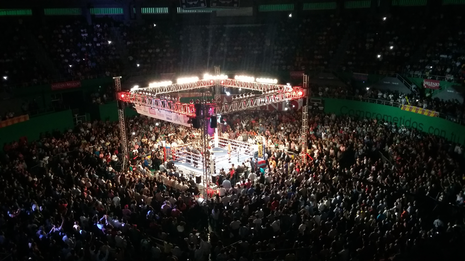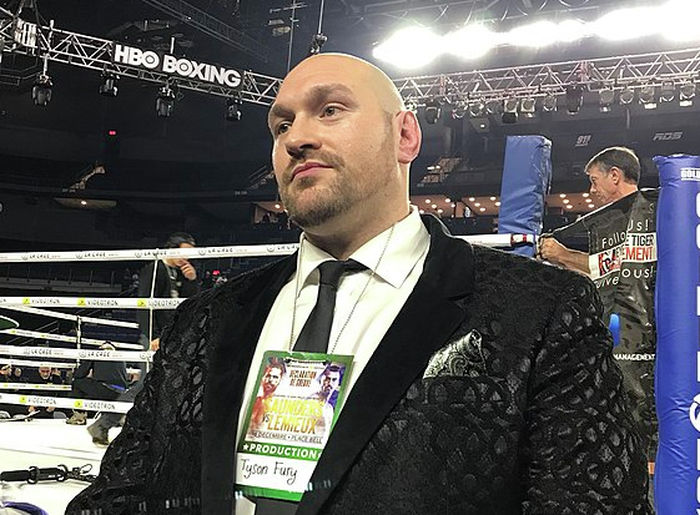Fury vs Ngannou: What on earth just happened?
Tyson Fury vs Francis Ngannou was meant to be a PR fight, but that all changed when Fury hit the canvas. Samuel Tarr breaks down the fight and its consequences

Last Saturday was one of the strangest nights in boxing history. Francis Ngannou made his debut in the sport against Tyson Fury, the man many consider to be the best heavyweight of his era, and almost won.
Even before the fight began I felt I was in for something surreal. After we were forced to sit through 45 minutes of vaguely musical acts hand-picked by a Saudi prince, the camera cut to the locker rooms, where Fury looked like he’d just got out of bed. Ngannou’s backroom warm-up was also unimpressive — it seemed like he was about to take ten million dollars worth of punches from a world champion boxer.
This was 2023’s answer to 1974’s “Rumble in the Jungle”, when promoter Don King had convinced Zaire officials to host a music festival, punctuated by a heavyweight title bout, to generate good publicity for Zaire’s regime. Now, every famous footballer and their mother was drawn to Saudi Arabia by the promise of a spectacle, despite the mismatch between the fighters. All eyes were on the desert.
When we got to see the two fighters in the ring, Francis Ngannou looked incredibly muscular and ferociously mean as he stared down Tyson Fury, who was sporting his signature look – that of the flabby man. But it was the flabby man who was the huge favourite when the opening bell rang. Fury had earned his reputation as one of the best of his era with wins over “Dr Steelhammer” Wladimir Klitschko and Deontay “The Bronze Bomber” Wilder. Meanwhile Ngannou, an MMA fighter by trade, was going into his first ever professional boxing match. A tough bloke, no doubt, but surely no match for Tyson Fury.
Fury certainly looked like the favourite when he made his way across the ring and thumped Ngannou with the first right he threw. For the champ, the first round was a slip, step and walk-down in the park. But by the second round, things were looking less cosy. In the third round, the “Gypsy King” hit the canvas.
Mania in Arabia. The thing that everyone really wanted to see happen but knew wasn’t really going to happen, had happened. The UFC marketing team had claimed that Ngannou had the hardest recorded punch in the world, but many of us just assumed they had taken the tests in the arcade section at Hollywood Bowl. Then, watching Ngannou with “GIMIK” written on his shorts stand over the downed world champion, the world realised that he was a serious puncher, and that this was a real fight.
Over the rounds, Ngannou continued to give the Gypsy King trouble. The Cameroonian had consistent success with jabs to the body, which punished Fury’s overreliance on “posting” defensively. Too often, Fury (who, at 6’9”, is the taller man in all his fights) will leave his lead arm outstretched in front of him to prevent the opponent from getting too close, leaving his midsection open in the process.
Ngannou also enjoyed some success from southpaw. Where right-handed fighters normally stand with their left foot and hand in front, the southpaw’s right side is forward. This means that when a southpaw fights an orthodox opponent, his front foot will almost be stepping on his opponent’s front foot. The southpaw boxer can then get that foot on the outside of his opponent’s, which lines his rear hand up with the opponent’s centre line. So when Ngannou was in southpaw, he got outside foot position and slipped his head to the outside of Fury’s outstretched lead arm, which allowed him to close the distance to land left hands.
Fury’s game of late has largely been based on the “punch and clutch”. This technique was instrumental in his victory against Deontay Wilder. Slipping and rolling punches is an art; clinching, on the other hand, seemed foolproof. If you can tie up your opponent, you can prevent them from throwing any punches in the first place. Once in the clinch, Fury would force Wilder to bear his gargantuan weight — just under twenty stone. This tactic took its toll on Wilder, who was outlasted over the course of the fight.
The Gypsy King was visibly uncomfortable in leading the dance against Ngannou, who was proving a savvy counterpuncher. To avoid the returning fire, Fury would lead with a soggy bat and immediately try to clinch. Ngannou, however, was equipped to neutralise this tactic. Whenever Fury looked to punch and clutch, Ngannou created a frame by driving his forearm into Fury’s collar, allowing him space to land short uppercuts. Unable to use his size to bully his opponent on the inside, Fury’s fighting system was falling apart.
Fury also missed several opportunities to punish Ngannou. Early on, Ngannou was overreacting to the threat of the jab, making huge parrying motions leaving his right hand at his waist. Threatening the jab, drawing the parry and coming around the side with a left hook is Boxing 101. Yet Fury lacks a solid left hook. He uses it as a slappy punch which moves the opponent’s head into the path of a right hand.
Ngannou had the counter left hook locked and loaded for whenever Tyson threw his own left, knowing that it would most likely be followed by a right. Indeed, this left hook over the right straight was the punch that dropped Fury.
But then there were stretches of the fight in which Ngannou, enamoured with his left hook, would swing it with abandon whenever Fury landed his own punch, and miss comically. Fury sought to exploit this tendency with feints. He threatened to step into range in order to invite the reactive left hook, then step back and counterpunch.
Yet the iron-chinned Cameroonian wasn’t so easily convinced. As Fury couldn’t hurt him with his best punches, Ngannou could fight without worrying too much about what was coming back at him. He, meanwhile, had cut and dropped Fury. After a few rounds, Ngannou had settled into the fight, and only one man was left flinching.
This does not bode well for Fury going into a fight with Oleksandr Usyk, who holds three of the four heavyweight belts. The Ukrainian will likely be able to fluster Fury at mid-range, whilst also being more savvy on the inside than Fury, whose “punch-and-clutch” will not get him far. Perhaps The Gypsy King will have learnt his lesson in this area after scraping a controversial decision over Ngannou. Yet this late into his career, at 35, it’s hard to see the old dog learning new tricks.
Most alarming of all for the Fury corner will be the way their fighter struggled when Ngannou fought out of southpaw. Usyk is a masterful southpaw, and was due to fight Fury on Dec 23rd. But one doubts that the fight will take place this year, if ever. Fury did not need another reason to duck Usyk. Besides, Ngannou has already made the Ukrainian’s point for him - it is now quite clear who the best heavyweight in the world is. Between struggling to put away an ageing Derek Chisora last year and being beaten up by a novice last weekend, it might just be that for Tyson Fury, the “time to face the Usyk” has passed.
 News / Clare Hall spent over £500k opposing busway 24 December 2025
News / Clare Hall spent over £500k opposing busway 24 December 2025 Comment / The ‘class’ of Cambridge24 December 2025
Comment / The ‘class’ of Cambridge24 December 2025 News / Caius mourns its tree-mendous loss23 December 2025
News / Caius mourns its tree-mendous loss23 December 2025 News / Girton JCR publishes open letter expressing solidarity with Palestine25 December 2025
News / Girton JCR publishes open letter expressing solidarity with Palestine25 December 2025 Comment / Yes, I’m brown – but I have more important things to say22 December 2025
Comment / Yes, I’m brown – but I have more important things to say22 December 2025










